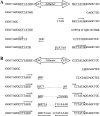Phylogenetic and functional characterization of the hAT transposon superfamily
- PMID: 21368277
- PMCID: PMC3120152
- DOI: 10.1534/genetics.111.126813
Phylogenetic and functional characterization of the hAT transposon superfamily
Abstract
Transposons are found in virtually all organisms and play fundamental roles in genome evolution. They can also acquire new functions in the host organism and some have been developed as incisive genetic tools for transformation and mutagenesis. The hAT transposon superfamily contains members from the plant and animal kingdoms, some of which are active when introduced into new host organisms. We have identified two new active hAT transposons, AeBuster1, from the mosquito Aedes aegypti and TcBuster from the red flour beetle Tribolium castaneum. Activity of both transposons is illustrated by excision and transposition assays performed in Drosophila melanogaster and Ae. aegypti and by in vitro strand transfer assays. These two active insect transposons are more closely related to the Buster sequences identified in humans than they are to the previously identified active hAT transposons, Ac, Tam3, Tol2, hobo, and Hermes. We therefore reexamined the structural and functional relationships of hAT and hAT-like transposase sequences extracted from genome databases and found that the hAT superfamily is divided into at least two families. This division is supported by a difference in target-site selections generated by active transposons of each family. We name these families the Ac and Buster families after the first identified transposon or transposon-like sequence in each. We find that the recently discovered SPIN transposons of mammals are located within the family of Buster elements.
Figures




References
-
- Abascal F., Zardoya R., Posada D., 2005. ProtTest: selection of best-fit models of protein evolution. Bioinformatics 21: 2104–2105 - PubMed
-
- Bessiere D., Lacroix C., Campagne S., Ecochard V., Guillet V., et al. , 2008. Structure-function analysis of the THAP zinc finger of THAP1, a large C2H2 DNA binding module linked to Rb/E2F pathways. J. Biol. Chem. 283: 4352–4363 - PubMed
Publication types
MeSH terms
Substances
Grants and funding
LinkOut - more resources
Full Text Sources
Other Literature Sources
Molecular Biology Databases

